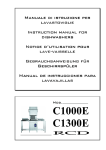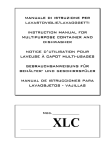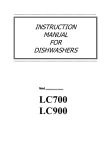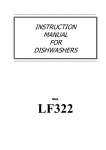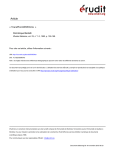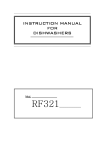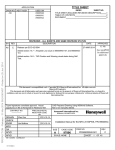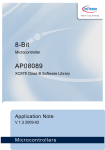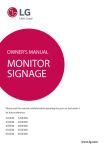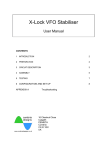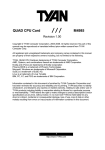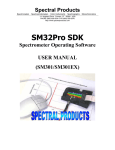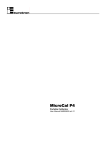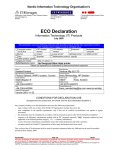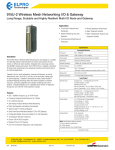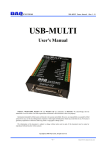Download C800E RCD - Comcater
Transcript
INSTRUCTION
MANUAL
FOR
DISHWASHERS
Mod.
C800E
MULTIPOWER
RCD
INSTRUCTIONS FOR THE USER
INTRODUCTION
1) Read carefully all instructions supplied in this manual which contains important
information for correct installation, use and maintenance. Keep in a safe place for
future reference.
2) After opening all packing, check to ensure if all is in order. If in doubt, do not use
and contact a qualified professional to check the appliance.Remove all packing
materials (plastic bags, styrofoam packing, nails or staples, etc.) away from the reach
of children as they can present danger.
3) Before connecting the appliance to the mains, ensure that your water and electrical
supply correspond to the requirements.
4) This appliance must be installed by a qualified technician according to the
manufactures instructions.
5) This appliance must only be used in the manner for which it is intended. Any
other use is considered improper and therefore dangerous.
6) This appliance should only be used by persons trained to use it.
7) When attending to the dishes after washing, proper hygiene must be carefuly
observed.
8) Do not expose appliance to temperatures below 0°C.
9) The protection factor of the machine is IP X4 and should not be washed using
direct jets of water at high pressure.
10) After turning off wall switch, only qualified personnel should remove panelling
for repairs.
11) This appliance conforms to D.M.13/4/89 according to the CEE directive 87/308,
relative to eliminating radio disturbances.
12) Conforms to CEE directive n. 23 of 19/2/73 and to the law n. 791 of 18/10/87,
our dishwashers are built according to the best technical rules in force in ITALY and
ABROAD and are covered by European certificates.
13) Noise level of the machine, less than 67dB(A)
1
INSTRUCTIONS FOR THE USER
INSTRUCTIONS FOR USE
2
INSTRUCTIONS FOR THE USER
THE COMMANDS PANEL
H9 a
b
S3
c
d
H9
Q1
S3
DISPLAY
S9
S10
S9
S10
Q1
3
INSTRUCTIONS FOR THE USER
OPERATION AND USE
HOW TO USE
1 Before using check that:
-it is plugged in
-the water supply is on
-there is water in the pipe
-the pump filter is correctly inserted
-the overflow pipe is connected
-the blades may move freely
-temperatures used are those which are recommended at 55°C for washing and 85°C
for rinsing.
-the crockery to be washed is in good condition and not cracked, as the cracks offer
more opportunity for the soiling to remain and floral bacteria to grow.
SWITCHING ON
When the machine is off, the display shows "O.F.F."
2 To turn on the machine press the
"Q1" switch.
The indicator light of the last cycle selected turns on ("H9 a-b-c-d").
The "H9b" indicator light turns on the first time the machine is turned on.
During the filling of the wash tank the display shows "F. .2.".
(
"S3" START button is "RED")
The booster hot water is used for the wash tank filling.
When the wash tank is full, the booster and tank heaters are turned on.
When the machine is ready, the display shows the tank temperature and the
(
"S3" START button turns "GREEN")
Using detergents which are chlorated and sanitized, they should be placed in the
machine using an automatic dosage device as when the detergent is poured directly
into the tank the possibility of formulation of dark spots may appear on the surfaces
as a result of the clorate
Dishes should now be put into suitable positions in the racks, after the removal of
solid waste. Cups and cutlery should be placed vertically in the suitable compartment.
Do not overload. The dishes should not be overlapped in such a way as the water
cannot reach every surface of the dish.
4
INSTRUCTIONS FOR THE USER
WASH CYCLE SELECTION
3. Press the
dishes:
"S9" button to select the wash cycle according to the dirtiness of the
• H9a short cycle:
for glasses and cups;
• H9b medium cycle:
for normally dirty dishes;
• H9c long cycle:
for particularly deep or dirty dishes and for
utensils;
• H9d intensive cycle: it is possible to perform an intensive wash that will
remain activated until the
"S3" button is pressed again or a maximum time
of 8 min. is reached; the pause, rinse and drain (if required) phases will follow.
STARTING THE WASH CYCLE
4.
Wait until the wash temperature reaches 55°C and the (
button turns ("GREEN").
"S3" START
Press and hold the
"S3" button (for about 10 sec.) to set the preferred startup
mode of the chosen wash cycle:
• "H9..." indicator light is on (Continuously):
For Automatic startup by closing the front door.
• "H9..." indicator light flashes:
For Manual startup Which is achieved by pressing the
"S3" button.
If the choice of startup of the cycle in automatic mode is performed with the
door open, it is necessary to open and then close the door to start the cycle.
During the washing cycle the,
"S3" START button is BLUE.
It is important to know that:
♦
The activation of a cycle is shown by the sequential lighting of the indicator
"S3" START button is BLUE;
lights of the display and
♦
During the wash or drain phases the display show’s the wash tank temperature;
♦
During the pause period nothing is displayed.
♦
During the rinse phase the display show’s the rinse temperature.
5
INSTRUCTIONS FOR THE USER
IMPORTANT
N.B.: Machine in conformity with the existing hygienic standards, guaranteeing
a final rinse at 82°C. Wash cycle automatically lengthened if final rinse
temperature is not reached.
To avoid the machine blocking in this intervention, after 8 minutes the
intervention is stopped and the cycle continues.
At the end of the washing operations turn off the machine by pressing twice the
"Q1" switch.
INTERRUPTION AND END OF WASH CYCLE
5 * It is possible to momentarily interrupt the wash cycle by opening the door; the
operations will resume by closing it .
At the end of the washing operations turn off the machine by pressing once or twice
the
"Q1" switch:
ONCE: the drain cycle will start automatically after 10 sec. ("C. .2.")
TWICE: the machine definitely in "O.F.F." .
* Upon turning on the machine again, the indicator light of the last cycle selected will
illuminate and the display will show the alarm code "A. .1." until a new cycle starts.
At the end of the cycle, remove the rack at an incline and shake carefully to remove
any remaining water drops or residue.
Leave dishes to dry and take out the rack with clean hands, paying attention to not
touch internal parts and borders. Remove dishes and place in a hygienic location.
SELF CLEANING AND DRAIN CYCLE
6 At the end of the wash operations turn off the machine by pressing the
switch.
After having removed the overflow pipe and lowered the hood, press the
button for 3 sec.
"Q1"
"S3"
The self cleaning and drain cycle will start, turning on the drain pump for machines
equipped with it.
The display will show "C. .1." during the entire cycle (2 min. and 30
sec.).
At the end of the autowash cycle, remove the tank filter to clean and replace along
with the overflow hose in the correct position. For further information regarding the
accessories please look under the section “USEFUL INFORMATION”.
6
INSTRUCTIONS FOR THE USER
MANUAL DRAIN
7 It is possible to empty the tank at any time of the day.
It is possible to perform this cycle only with the machine turned on.
Press the
"S9" button for 5 sec. The drain cycle will start.
The display will show "C. .2." for the entire duration of the cycle (2 min.
and 20 sec.).
At the end of the cycle it is recommended to remove the filters in the wash tank for
cleaning, replace them in their correct positions after cleaning.
READING THE TEMPERATURE
8. By pressing the
"S10" button it is possible to view in sequence the actual
temperatures and the programmed temperatures of the tank (t1) and of the rinse
booster (t2) for the selected cycle.
t1
The display show:
"x.x. ." : tank temperature
"x.x.P." : tank temperature set
t2
The display show:
". .x.x.": rinse temperature
" P.x.x." : rinse temperature set
The operations described above cannot be performed during a cycle.
7
INSTRUCTIONS FOR THE USER
DEACTIVATING THE DISHWASHER AT THE END OF THE DAY
9. At the end of service, switch off the electrical supply by the main isolating switch
and close the water supply valve.
WARNINGS WHILE WASHING
1) Check that the washing temperature stays at 55°C
2) Do not use bare hands when handling soapy water.
immediately and thoroughly under fresh running water.
If this occurs rinse
3) While the machine is operating, do not turn any knobs too quickly.
4) Use only chlorified anti-suds detergent specifically for industrial use.
5) Turn off machine in case of breakdown or malfunction.. For repair, contact
only authorized technical assistance outlets using only genuine parts.
6) Under no circumstances should the settings of the thermostats be altered.
7) When running continuous cycles throughout the day, change the washing tank
water 2 or more times.
8) Do not subject washed dishes to any other handling such as rotary brushes, vapors,
dish-cloth drying etc.
Mishandling of any of the above may compromise the safety of the appliance.
8
INSTRUCTIONS FOR THE USER
USEFUL ADVICE
1) MAINTANANCE: Before beginning any cleaning or maintenance operation,
the machine MUST be isolated from the main power supply.
Frequently check and clean the wash and rinse arms, taking them out from the
column to remove any debris or scale build up.
The frequency of this operation is regulated by the quantity of residue or by poor
washing results.
For internal and external cleaning of the machine, do not use corrosive products
such as sodium hypochlorite (bleach) or hydrochloric acid (muriatic acid), steel wool
or steel brushes.
To ensure correct functioning of the machine, in the presence of calcium salts or
magnesium in the water you are advised to periodically descale the machine and keep
in good order by using qualified technicians who are authorised to perform this
service.
To avoid the risk of damage from oxidization or corrosion from chemicals, keep all
steel surfaces clean.
2) FOR BEST RESULTS: An insufficient wash cycle may occur which is visible
when traces of waste remain. Streaking may be caused when the rinse cycle is
insufficient, in which case check that the rinse nozzles are clean and that the water
source is of suitable pressure.
In case of waste remains check that:
-the wash cycle nozzles are clean.
-the wash cycle temperature is at 55°C.
-the detergent is chlorified, of the correct concentration and specifically for industrial
use.
-the suction pump filter is clean
-the dishes are in the correct rack
-the dishes are placed correctly in the rack
3) PROLONGED DISUSE
In case of prolonged disuse, a few weeks, it is advisable to run the machine empty a
few times with clean water so as to avoid the build up of any odors. If necessary
repeat this operation a few times until the the water at the end of the wash is good and
clean.
If the period of disuse is longer, it is advisable to oil stainless steel surfaces with
vaseline and to remove any water from the boiler and the electric pump. It is always
advisable to run the sanitizing and de-encrustation operations both before and after
periods of disuse.
9
INSTRUCTIONS FOR THE USER
4) SANITIZING
It is vital to thoroughly clean the machine at least once a week. It is advisable to use
specifically a detergent which disinfects, the use of which will substantially increase
the following advantages:
-Establishes a secure hygenic state by using active detergents and disinfectants.
-maintains the machine in perfect hygienic conditions even during periods of nonuse.
At the end of the operation, it is necessary to run the machine empty,so as to rinse it,
for a few minutes.
5) DISENCRUSTATION
In the presence of the use of hard water, lime deposits may formulate internally and
on the dishes, which for hygienic reasons and for good care of the machine must be
removed by disencrustation.
The frequency of such procedure is according to the detergent manufacturers advice,
those products which generally contain a phosphoric acid base.
So as not to damage the machine, do not exceed doses and when the operation is
complete, rinse thoroughly.
6) LOADING AND UNLOADING OF THE MACHINE
For the transportation of the machine from the delivery point to the final installation
position, use a fork lift or adequate lifting equipment used by authorised staff. Lift the
machine by its frame, taking care that any protruding parts are not damaged
(discharges, wiring etc.).
7) MACHINE DISMANTLING
At the end of its normal lifetime, the machine has to be taken apart according to the
local regulations in force by separating the components as follows:
♦ metal parts: hood, platforms, frames, filters
♦ electrical parts: motors, remote control switches, microswitches, wiring
♦ plastic parts: racks, connections
♦ rubber parts: tubes, sleeves
10
INSTRUCTIONS FOR TECHNICAL PERSONNEL
INSTRUCTIONS FOR INSTALLATION AND MAINTENANCE
This manual should be used by qualified personnel, authorized to examine and
eventually repair the machine.
The Manufacturer takes no responsibility for action taken by non-qualified personnel.
11
INSTRUCTIONS FOR TECHNICAL PERSONNEL
INSTALLATION
During the installation keep the machine leveled in order to ensure proper functioning
(angle of inclication is maximum 2 degrees). To prevent damage caused by the
release of vapors from the accessories, ensure that any adjacent equipment will not be
damaged by these vapors.
After test-running the machine, check that the temperatures used are the
recommended ones at 55°C for washing and 85°C for rinsing.
1) ELECTRICAL CONNECTION:
The electrical safety of this equipment is only assured if it is connected as follows.
It is necessary to connect the equipment to an effective earthing as specified by the
electrical safety regulations in force. Check that this basic requirement is complied
with, in case of any doubt ask for a careful check of the installation by a qualified
personnel.
In the case the earthing is not efficient there will be a dispersion due to the
suppresser.
The machine shall be included in a correctly dimensioned equipotential, whose
effectiveness is to be very tight in accordance to the procedures set for in the
applicable safety standards. The connection shall be performed through a screw
marked by a plate near the rear side of the appliance.
The manufacturer declines any responsibility for any damages caused by lack of an
effective ground installation. For the electrical power supply have available a wall
circuit breaker switch with multiple phase protection according the following table
with contact aperture distance, equal to or not exceeding 3mm and a supply cable no
less than 2.5mm².
kW
220/230V∼
∼ 400/415V 3N∼
∼
8.75kW
40A
16A
6.10kW
32A
16A
3.41kW
16A
10A
For other supplies the cable cross section and the circuit breaker switch must be
calculated according to voltage and length of cabling. If cabling too long adjust cable
size to Amp rating; do not pull on supply cable or install it under tension. If cable
needs to be replaced use type H07RN-F.
12
INSTRUCTIONS FOR TECHNICAL PERSONNEL
2) WATER SUPPLY
Provide a water tap in an accessible location, size 3/4" gas, and that which is
connected first to the filter, then to the discharge tube which are a part of the
machine. Pay careful attention to National and Regional requirements.
The pressure used should not be under 2 bar or over 4 bar (200-400 kPa). If the
pressure is below this requirement, you are advised to install a pressure increasing
pump; if the pressure is over this requirement, use a pressure reducer.
For best results, it is advisable to have the inlet water with a hardness not more than
10°French measure.
For a hardness factor higher than this use an ionised switch or invert the osmosis.
3) DISCHARGE
Provide a discharge at ground level with a syphon and connection to the machine
consisting of a flexible tube, placed in a way that it inclines towards the final
discharge location. Moreover, ensure that the length is not twisted. Ensure that the
discharge tube can withstand temperatures up to 70°C.
4) LIQUID BRIGHTENER DOSAGE
The dosage from this compartment is regulated by the regulation screw, of which
after being screwed down completely, should then be unscrewed, three complete
rotations.
To fill the dosage tube, turn the machine on without the overflow in place. Now turn
the machine on and off. Repeat this operation a few times at intervals of a few
seconds until the brightener reaches the compartment. Now wait until the machine
reaches the correct temperature.
Then run a few cycles empty and wash normally: if the washed items show
dropspots, it signifies that the brightener level is low; if there is streaking however, it
signifies that there is too much brightener or that the water is too hard. The variation
is according to the type of brightener used.
Now the machine will automatically draw the necessary amount of liquid for each
rinse; when running the wash operations check that the liquid in the drawer does not
run short.
5) DETERGENT DOSAGE
With the screw on the side of the detergent pump, close completely the product
intake, then slowly open the screw until the desired intake quantity has been reached.
The correct quantity is indicated by the detergent supplier. Check that the intake of
the pipe during the rinse cycle is as preset. (8cm = 1g approximately). Maximum
intake or delivery distance: 2 meters.
13
INSTRUCTIONS FOR TECHNICAL PERSONNEL
6) VIEWING AND SETTING PARAMETERS
There are three types of programmable parameters:
P machine functions
(0/1);
T tank or rinse temperatures
(for each single cycle);
L cycle time
(for each single cycle).
1. The parameter programming environment can be accessed only with the
machine off, by pressing the
"S3" button. for 15 sec.
The display will show "P.r.o.":
- The lamp of the selected cycle flashes
"S9" button
- To change the wash cycle press the
- To set the t and L parameters, press the
2. Pressing
"S10" button.
"S3" button, the display shows all parameters and their settings:
P1-P2-P3-P4-P5-P6-P7-P8-Cr-FHR - t1-t2 - L1-L2-L3-L4-L5 - PRO
3. Use the
"S9" or
.
"S10" buttons to change the state of the parameter.
4. To confirm the setting, press
"S3" button.
To exit the programming environment just do not press any button for at least 20
sec.
14
INSTRUCTIONS FOR TECHNICAL PERSONNEL
PARAMETERS SETTING
PARAMETER
FUNCTION
STATE
P1
Water fill
1
P2
Normal / with pre-rinse
0
P3
Heating commutated/simultaneous
0
P4
N° wash pumps 1 / 2
0
P5
Booster safety not active / active
1
P6
Startup safety on the temperature tank not active
0
P7
HR / HRT
0
P8
/
0
Cr
/
0
FHR
Standard short cycle / short cycle with reduced rinse:
(L3: 9sec – L5: 5sec)
CT
PARAMETERS
Cycles counter
FUNCTIONS
0
1…….
SHORT
MEDIUM
LONG
INTENSIVE
CYCLE
CYCLE
CYCLE
CYCLE
(H9a)
(H9b)
(H9c)
(H9d)
t1
TANK
TEMPERATURE
55°C
55°C
55°C
55°C
t2
RINSE
TEMPERATURE
85°C
85°C
85°C
85°C
L1
WASH TIME
37 sec.
77sec.
127sec.
457sec.
L2
PAUSE TIME
0.
0
0
0
L3
RINSE TIME
18 sec.
18 sec.
18 sec.
18 sec.
L4
OSMOSIS RINSE
TIME
(Optional)
(15)
(15)
(15)
(15)
L5
DRAIN TIME
7 sec.
7 sec.
7 sec.
7 sec.
6.1 STANDARD PARAMETER CONFIGURATION
See page "19" for the standard configuration.
N.B.: Pressing the "S10" button for 20 sec. (the display shows "P.S.t.") when the
machine is off automatically configures all the parameters (P-T-L) as shown in the table.
15
INSTRUCTIONS FOR TECHNICAL PERSONNEL
7) SELF DIAGNOSTICS: ALARMS AND FUNCTIONS ON THE
DISPLAY
"S3" Start button flashes (BLUE/ORANGE: during the wash cycle)
"S3" Start button flashes (ORANGE: with machine in stand-by)
♦
OFF.:
MACHINE OFF.
♦
A 1:
CYCLE NOT COMPLETED (appears upon turning the machine on after interrupting a
cycle using the "Q1". main switch).
♦
A 2:
BOILER OVERHEATING (the temperature in the boiler exceeds 105°C – the active
cycle is finished).
♦
A 3:
TEMPERATURE PROBE NOT CONNECTED (the heater of the probe in alarm state
is disconnected - the active cycle is finished).
♦
A 4:
TANK NOT FILLED WITHIN 30 min.(turn off and then turn on the machine).
♦
A 5:
BOILER NOT HEATING WITHIN 30 min.
♦
H 1:
RINSE WATER TEMPERATURE (at least 15°C below the set value - the active cycle
is finished).
♦
H 2:
NO WATER SUPPLY (no incoming water for at least 2 sec. –OPTIONAL - the active
cycle is finished).
♦
H 3:
TANK TEMPERATURE (at least 10°C below the set value - the active cycle is
finished).
♦
F 1:
DOOR OPENING (opening the door during a cycle).
♦
F 2:
INITIAL LOADING PHASE.
♦
C 1:
SELF CLEANING AND DRAIN CYCLE (for the entire duration of the cycle).
♦
C 2:
DRAIN CYCLE (for the entire duration of the cycle).
♦
C 3:
REGENERATION OF THE WATER SOFTENER (for the entire duration of the cycle).
♦
P.r.o.: PARAMETERS PROGRAMMING.
♦
P.S.t.:
PRESET LOADED.
In case of multiple simultaneous alarms the display will show the codes on the basis of the
following priorities:
1.
H1-H2-H3
2.
A1-A2-A3-A4-A5
3.
F1-F2
16
INSTRUCTIONS FOR TECHNICAL PERSONNEL
CONSUMPTION
Model
Tank
Capacity
(L)
C800E
21
Water
Consumption
per cycle (L)
Tank
Heater
(W)
Boiler
Heater
(W)
3,5
2.000
9000
MAX
Pump
(W)
Total
Power
(W)
750
10750
MAX
Max
hourly
capacity
with water
at 55°C
Max water
capacity
with water
at 12°C
36/30/20
MAX 36
The rack capacity diminishes for water feeders with a lower capacity.
17
INSTRUCTIONS FOR TECHNICAL PERSONNEL
ELECTRICAL INFORMATION
A1
Control console
A2
Printed circuit board
B2
Probe for booster temperature
B3
Probe for tank temperature
C1
Noise filter
C2
Capacitor
C3
Capacitor
E2
Booster heater
E3
Tank heater
FA2
Printed circuit fuse
K1
Main relay
KE2
Booster heater contactor
KE2b
Booster heater safety contactor
M2
Rinse booster pump
M3
Wash pump
M5
Drain pump
MD
Detergent dispenser
S1
Door micro switch
S11
Pressure switch for RCD
S2
Tank pressure switch
SE2b
Booster heater safety thermostat
SE3b
Tank heater safety thermostat
Y11
Water inlet solenoid valve
X1
Terminal block
The Manufacturer takes no responsibility for any printing errors in this manual. The
Manufacturer reserves the right to modify products, if necessary, without changing
the main characteristics of the product.
18
INSTRUCTIONS FOR TECHNICAL PERSONNEL
19
900756
10-2010






















